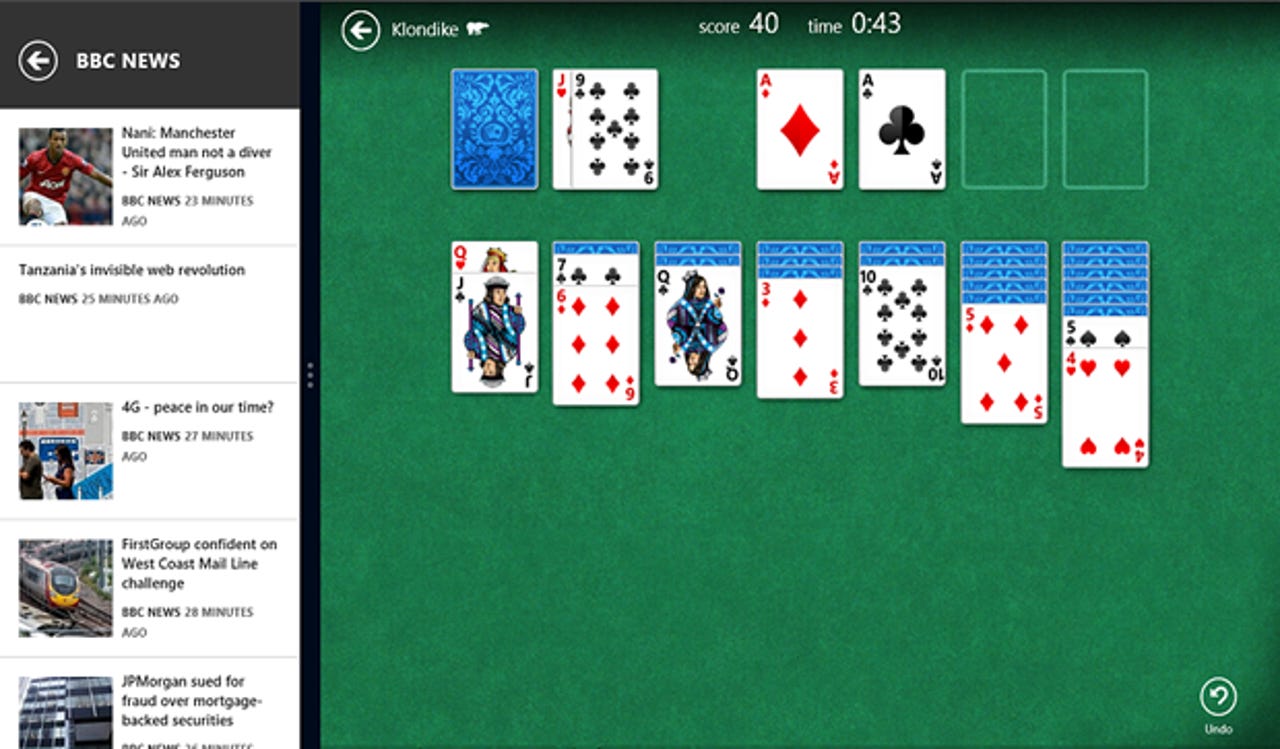HP's ElitePad is missing an elite Windows 8 feature: Snapped view

Snapped view is a Windows 8 feature that allows you to work with two apps at once by positioning them side-by-side on the screen. Compared to "normal" Windows where you can run any number of apps in any configuration it sounds a bit naff, but in the Metro-ified, "reimagined" world of Windows it's fantastic.
Snapped view has near universal acclaim amongst the Windows 8 early adopters that I've spoken to over the past year. It fixes the iPad's "single serving friend" problem that whereby you're trying to work in one thing, but glance at another, you have to keep jumping in and out of apps. Snapped view allows you with a swipe of the finger to move in and out of "dual focus" mode without noticable effort.
Here's an example of what it does:

So I was surprised when James Kendrick pointed out that HP's new ElitePad 900 can't do Windows 8 snapped view.
To support snapped view, you need a certain width screen. The snapped view itself (which can sit on the left or right) is 320 pixels wide. Add this to a standard 1024 wide display and you get 1366 pixels. Microsoft's minimum recommended design size for a Windows 8 or Windows RT device is therefore 1366 pixels, specifically to support snapped view.
Read the press release for the HP ElitePad 900 and you'll find a specific footnote that reads:
"This system is Windows 8 certified and supports the Windows Store user interface. The integrated display resolution is below the threshold for Snap, a Windows Store interface feature that allows two Windows Store applications to be viewed simultaneously. This feature may be enabled by attaching an external 1,366 x 768 or higher resolution display."
(If I were being nit-picky I'd point out that it's called "snapped view" not "Snap", and that it's a Windows 8 UX feature, not a Windows Store interface feature.)
In fact, the screen resolution on the ElitePad is 1280x800. Weirdly, if you look at the tablets that were announced at IFA, they do all support snapped view. HP is hanging out there on its own on this one.
Developers: how to design for snapped view
The Windows Store certification guidelines call out that "your app must support a snapped layout". Not every function has to be made available in snapped view, but your app must generally work whether snapped or not.
The implication with snapped view is that it's a ton of extra work to do as you have to make sure you support snapped view in each and every page that makes up your application. In practice, it's not that hard. If you're properly separating your markup and code - my recommendation is to use MVVM Light for this. You should budget about - finger in air - 25% additional build time per page that you want properly functional in snapped view.
However, the point is you do need to do it. Even if you're sideloading apps and avoiding the store, to provide a great experience for your users snapped view is a must.
Buying tablets
If you're looking to buy a Windows 8 or Windows RT tablet for yourself or to deploy in your business, make sure the screen resolution is high enough to support snapped view. It's so good, that I'm confident you and/or your users will love you for it.
It's a real shame that HP failed to deliver a snapped-view capable device here. Especially because it has an onboard cellular modem (which is either standard or an option). Those are not getting a great showing in devices that have been announced so far, but they're on my "what must a post-PC device have to be a post-PC device" checklist. You need always-on connectivity wherever you are.
It's fair of me to point out that if you plug it into a monitor, provided that runs at 1366 pixels wide or better you'll get snapped view, but the real win of of snapped view is when you're mobile, not when tied to your desk.
Great looking device, with a great name, but wait until the hardware gets rev'd and they put a wide enough screen in it before you part with your cash.
Update: HP have put out a blog post detailing why the screen is the way it is. tl;dr - it's intentional, and it's because Outlook doesn't support snapped view. Of course, Outlook does support snapped view, because all the "legacy" desktop apps do. You can't run it in the little snapped view, but you can run it in the fill view whilst a Windows Store app runs at the side. My preference would be that they came out with a proper reason (e.g. "it's an oversight", or "supply chain issues"), and actually gave a timescale for a resolution. As I said previously, businesses won't buy Surface - we need companies like HP, Lenovo, and Dell to have a really good showing in the space. HP is letting the side down with this.
What do you think? Post a comment, or talk to me on Twitter: @mbrit.